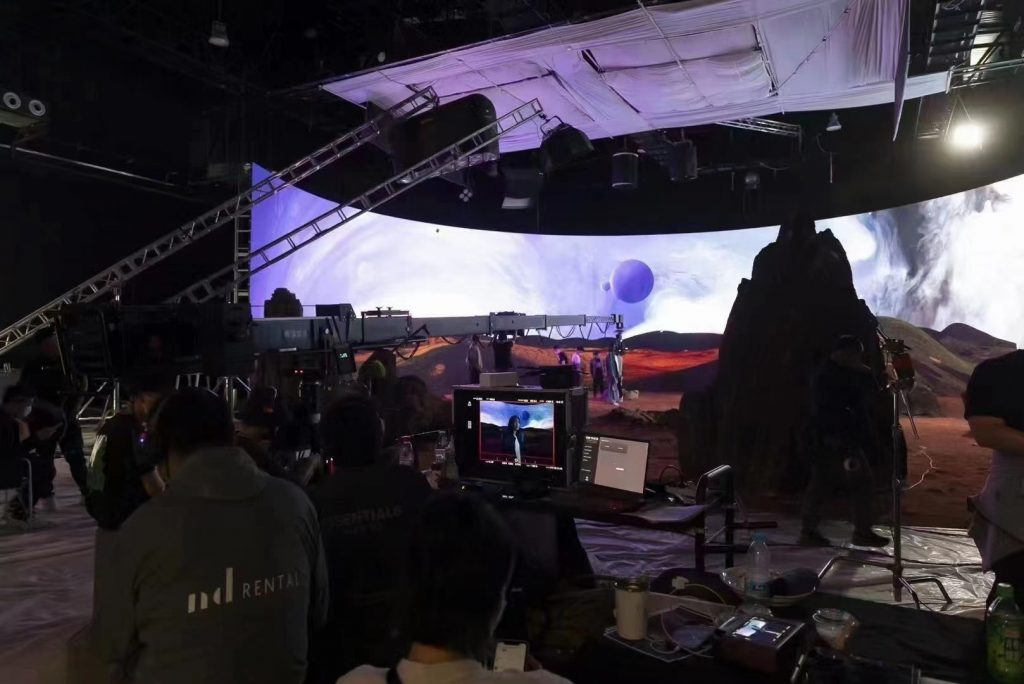According to LED SCREE, many LED display manufacturers have begun to improve the combination of LED display and XR virtual shooting technology this year. Judging from the market share increasing year by year, LED displays are used in XR virtual shooting environments. It is very good to use it. Here we need to understand the responsibilities of the LED display in XR virtual shooting.
What role does the LED screen play in XR virtual shooting?
First of all, in the current XR virtual shooting project, the LED display is mostly used as the scene simulation environment. It is reported that in the XR virtual shooting, the hardware display part includes a large LED screen, a large screen splicer, an external video module, a multi-channel rendering server and a control server.
The current XR virtual shooting projects mainly use small-pitch, high-density LED displays to build a simulated display environment. According to experts’ research, the current XR shooting main push points in the market have a pitch of P1.667, P1.875mm, P2.678mm, etc. The area resolution of the overall stitching can reach 8k, which can achieve a clearer simulation effect.

It is reported that compared to projectors, the cost of a 4-6-sided simulation environment built by small-pitch high-density LED displays is much lower than that of 4K projectors.
Can the LED display XR virtual shooting market continue to grow?
The process of this year is almost halfway through. In the LED display market, where demand has dropped significantly, XR virtual shooting has shown new vitality. Since the fourth quarter of last year, LED display companies have also started a number of film and television cooperation, and built virtual studios in many places.
Although compared with last year’s XR virtual shooting market, it has passed its infancy, but it has entered a new round of development cycle.
From the perspective of film and television shooting, the replacement of studios is slow and the market demand is limited. The current XR virtual shooting application scenarios are constantly expanding and developing towards diversified scenarios.
The widening of this demand scenario includes the application of XR virtual shooting in the press conference and other scenarios due to the impact of the epidemic, and also includes the popularity of the metaverse style in the terminal market. The pursuit of “breaking dimension” style such as virtual humans also brings XR virtual shooting new soil.

Since the XR virtual shooting became popular last year, LED displays have achieved certain results in this regard. According to Unilumin’s 2021 annual report, the sales of ROE, a wholly-owned subsidiary of Unilumin, in the global XR market have grown significantly, with XR business revenue of 980 million, an increase of 139.59% over the same period last year; Alto Electronics has also signed a new contract in the field of XR virtual shooting The contract exceeded 150 million yuan, and a total of 21 XR virtual studio projects were undertaken; LED SCREE has also launched offline stores in many overseas regions, allowing customers to experience the novelty brought by technology.
Of course, in addition to the above display companies, there are also many companies that have gradually accelerated the layout of XR virtual shooting during the year. It can be seen that there are cases of studio construction at home and abroad.
Summary: In 2022, the overall demand for XR virtual shooting has risen. The reasons include the impact of the epidemic and the diversification of scenes, which have further promoted the establishment of multiple studios and the demand for virtual shooting on stage screens. At the same time, under the current environment, XR virtual shooting is also facing the impact of rising raw material prices and logistics difficulties under the epidemic. However, compared with the traditional LED large-screen market, XR virtual shooting, as an emerging market, has high growth potential and market potential. larger.
So in the context of diversified applications, will XR virtual shooting gain a new sensory experience in the future? Presenting us with new technologies that are more realistic and more interactive? We will wait and see.